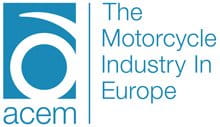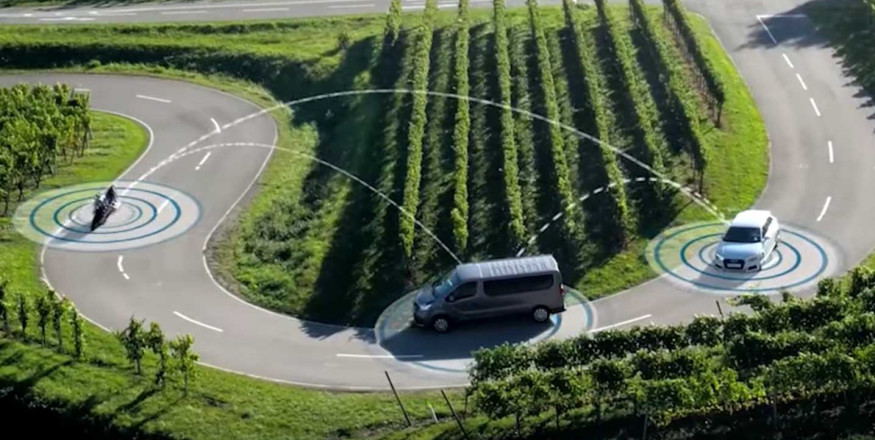Cooperative Intelligent transport systems
One of the most frequent human errors in accident situations is failure to see motorcycles within traffic, either due to the driver’s lack of attention, temporary view obstruction or low conspicuity of the motorcycle. This issue can be addressed by Cooperative Intelligent Transport Systems (C-ITS) which provide “digital conspicuity” to surrounding vehicles by warning drivers of oncoming motorcycles.
The motorcycle industry sees vehicle to vehicle (V2V) communication as a technology with a high potential to improve road safety across the EU and to lead to better integration of motorcycles in the transport system.
ACEM members have participated together with relevant national authorities in several road safety campaigns. These campaigns have focused on encouraging drivers to look for motorcyclists on the road. This is particularly important given that a high number of collisions are caused by car drivers noticing very late or even completely overlooking riders. Safety campaigns have also focused on the promotion of voluntary post-license training and of conspicuous and protective gear among riders.
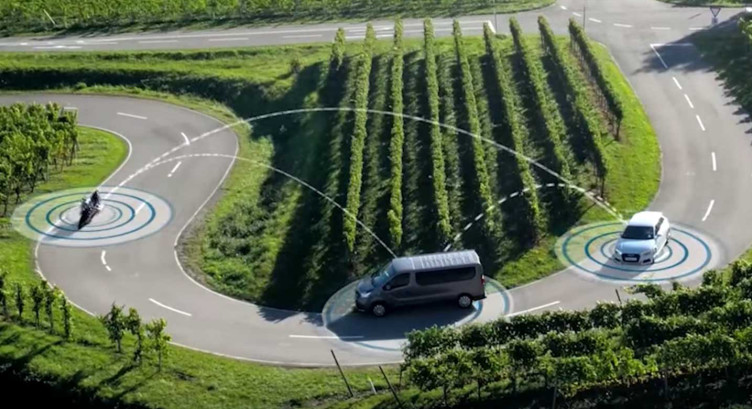
Connectivity between vehicles would allow the possibility to warn drivers and riders of potentially dangerous situations. Source: Autotalks Ltd.
From the Memorandum of Understanding on C-ITS to the Connected Motorcycle Consortium
In March 2014, the motorcycle industry adopted a Memorandum of Understanding on C- ITS. The objective of this MoU was to coordinate the deployment by industry players of safety relevant C-ITS technology on motorcycles in the European market. The Memorandum is an expression of individual and collective commitment of ACEM manufacturing members to realise a shared objective to the benefit of everyone.
In 2015, building on the MoU on C-ITS, motorcycle manufacturers, suppliers, researchers and associations joined forces to create the Connected Motorcycle Consortium (CMC)3 to ensure the integration of motorcycles into the future landscape of connected mobility.
The main objective of this platform has been to define common basic specifications for motorcycle ITS in areas such as: triggering conditions, localisation accuracy, algorithms and communicated data, as well as rider interface and antenna performance. These are very challenging problems from a technical standpoint. Specific engineering solutions are needed because ITS developed for cars are simply not transferable to motorcycles due to the differences in vehicle’s dynamics.
The CMC journey began with the launch of the ‘Basic Specification’ in 2020 focusing on evaluation, verification and requirements standardisation. Since then, the CMC has progressed further with some key findings from its accident research, insights into rider behaviour, and detailed information about some safety applications.
Motorcycle safety use cases were demonstrated at the Dekra Lausitz test track, Germany in late 2023. Together with various car OEMs at this live demo event the consortium showed several interactions between a car and a motorcycle where C-ITS applications or Advanced Driver Assistance Systems will help to mitigate the chance of a collision.
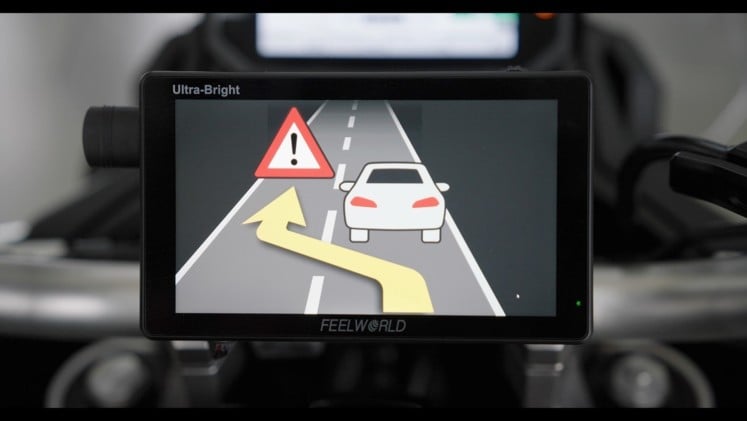
Based on connectivity a ‘Do Not Pass Warning’ informs the rider about a potential critical situation, demonstrated at the CMC live demo event at Dekra Lausitz test track, Germany in late 2023
USE Case scenarios developed by the CMC
The CMC is working on around 30 ‘use cases’ in which connectivity between vehicles would allow the possibility to warn drivers and riders of potentially dangerous situations. The use cases include motorcycle approach indication and warning features which help other vehicle drivers to detect motorcycles. The use cases also include dedicated applications for motorcyclists.
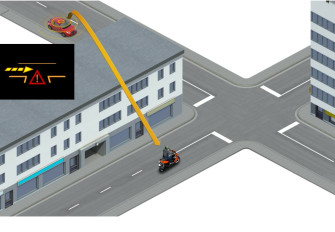
Motorcycle approach indication: MAI informs a vehicle driver that an approaching motorcycle is nearby, even if the driver cannot see the motorcycle.
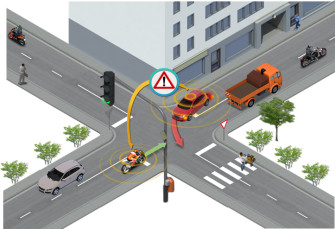
Motorcycle approach warning (left turn assist): MAW checks if vehicle drivers overlook an oncoming motorcycle, or incorrectly estimate its speed. It displays a warning to the driver if necessary.
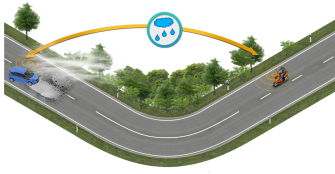
Adverse weather warning: AWW warns the rider about critical weather conditions ahead, particularly when they are hard to perceive in advance: fog, wind gusts, black ice, heavy rain etc.
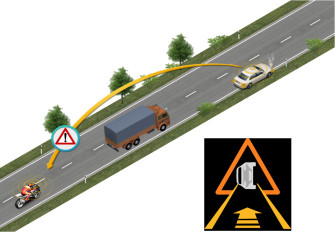
Broken down vehicle warning: BDVW warns that the motorcycle rider is approaching a vehicle with a defect that might be blocking a lane creating a potential safety risk.
Image source: C2C-CC toolkit
The CMC has made significant progress and breakthrough results have been achieved in motorcycle approach indication, motorcycle approach warning and Day 1 applications.
Moving into 2024, the Connected Motorcycle Consortium has entered its third phase nicknamed ‘CMC 3.0’. The focus for the coming three years will be on further research on both accident scenarios and simulation. In addition, standardisation and cooperation with other consortia and governments will continue.
Creating the conditions for market uptake of C-ITS
Certain C-ITS solutions may be suited for some types of models but not for others. Manufacturers implement technical solutions and optional features according to their vehicles’ needs, within a competitive business environment, ensuring that core functions and interoperability are preserved. The industry is also committed to guarantee that safety related C-ITS are interoperable between motorcycles and other vehicles.
C-ITS equipped motorcycles will soon be available in Europe, but in order to ensure market uptake it is essential to complete ongoing standardisation activities, validation and field operational tests. Cooperation with other players, including the automotive sector, infrastructure organisations and public authorities, especially with regard to investments in infrastructure and the deployment of a clear legal framework.
Cooperating with stakeholders in the field of C-ITS
ACEM works with stakeholders to ensure the successful deployment of ITS solutions in many ways. The industry actively participated in the European Platform for the Deployment of C-ITS, as well as in the Single Platform for open road testing and pre-deployment of cooperative, connected, automated and autonomous mobility to make sure that motorcycles are considered in the pre-deployment scenarios.
“ACEM works with stakeholders to ensure the successful deployment of C-ITS solution."ACEM joined also the Connected, cooperative and automated mobility association (CCAM) representing the private side of the CCAM Partnership, bringing together 230 innovation stakeholders involved in the connected, cooperative and automated mobility field.
Moreover, ACEM manufacturers have been contributing to the work of the CAR 2 CAR Communication Consortium and liaised with other players such 5GAA.
eCall systems for motorcycles
In case of an accident, the eCall systems have the potential to help riders using motorcycles mainly in rural and remote areas to communicate to relevant entities that an emergency occurred.
An eCall solution based on Third Party Service (TPS) has already been offered as optional for some years. Riders are also able to use some aftermarket products available on the market, such as smartphone APPs, or a rider based eCall systems (connected to helmets, jackets, or airbags).
The motorcycle Industry supports a diversified and flexible approach towards motorcycle eCall systems, which will be a strong enabler for future innovation. Vehicle based eCall systems require the consideration of certain motorcycle specificities.
Industry activities
Paving the way for the future deployment of 112 based In-Vehicle-Systems (IVS)
Between 2014 and 2017, a group of ACEM members participated in the European project I_HeERO, to investigate how an eCall system for motorcycles would work. The I_HeERO project concluded that an eCall for two- and three-wheeled vehicles significantly differs from the one used in passenger cars. The project therefore defined the minimum requirements for a motorcycle-specific eCall system, embedded in the vehicle.
On the basis of I_HeERO project recommendations, the industry worked together with public authorities to adapt the existing CEN standards. As a result, CEN/TS 17249-5 (“eCall for UNECE Category L1 and L3 powered two-wheeled vehicles”) and the CEN/TS 17249-6 (“eCall for UNECE Category L2, L4, L5, L6 and L7 tricycles and quadricycles”) were published in 2018.
The CEN technical specifications for eCall devices for motorcycles were assessed within the framework of the sAFE project. This EU co-funded initiative brought together industry players and Public Safety Answering Points (PSAPs) to carry out validation tests in various EU countries. The revision of technical specification TS 17249-5 has been promoted to “EN” standard level. The constant and proactive industry participation made possible the creation of a standard tailored for L1&L3 category vehicles.
Public safety answering points (PSAPs) – standards for common interpretation needed to support future voluntary deployment to avoid false calls
PSAPs should be able to handle a PTW eCall from all potential technology solutions (IVS, smartphone, TPS, aftermarket). The Optional Additional Data (OAD) inside the standard Minimum Set of Data (MSD) are used to describe special characteristics of eCall vehicles other than M1/N1 and require a common PSAP interpretation.
ACEM is open to further discussions on this matter with the European Commission and the eCall community in the context of the ongoing PSAP study by the EC.
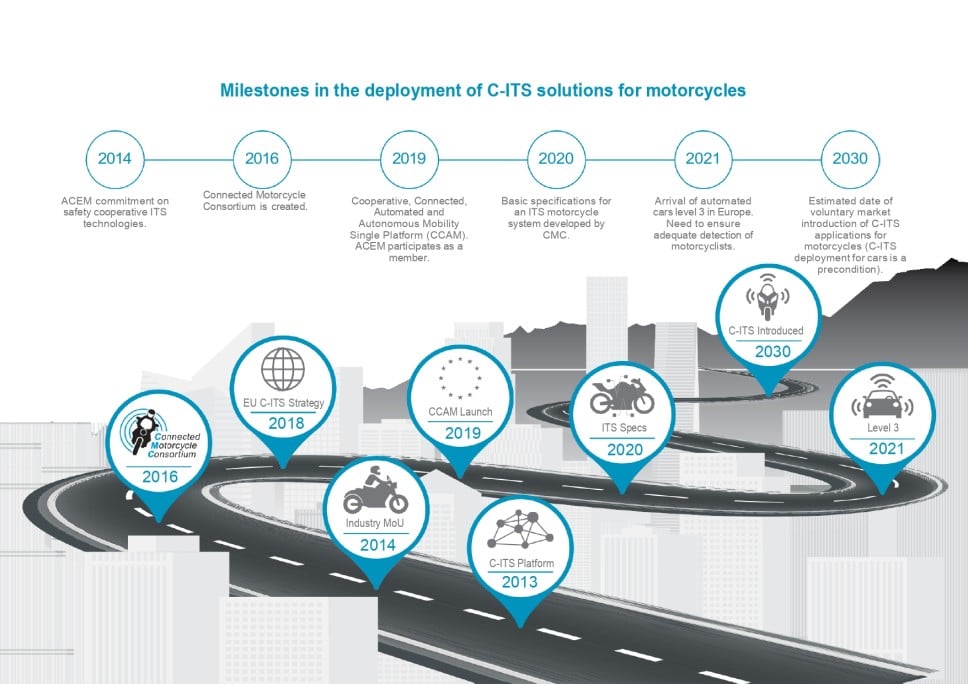
ENSuring that ADAS and future automated cars are safe for all road users
Cars equipped with ADAS (advanced driver assistance systems) are able to detect larger objects, with a defined or standardised shape, such as cars, trucks and traffic signs. However, the detection of smaller dynamic objects such as motorcycles in general presents challenges to sensors and algorithms, just as it presents challenges to human perception.
Therefore, automated systems should strive to improve the detection rate of motorcycles. Statements such as, “the system may not detect small vehicles like motorcycles”, that can still be found in some driver handbooks, are simply not acceptable from a safety point of view.
Vehicles of automation level 3, will have to be able to recognise the complex manoeuvres commonly undertaken by motorcycles in ordinary traffic (e.g. lane utilisation, lean for cornering, lane splitting and weaving in traffic, etc.). Regardless of their degree of automation, passenger cars and other vehicles must be able to recognise motorcycles and their inherent complex manoeuvres and react accordingly.
The motorcycle industry calls on policymakers to address this safety issue as a matter of urgency. Advanced drivers’ assistance systems and future automated cars must be able to identify and react to motorcycles in a safe manner.
Moreover, both the car and motorcycle industries must learn from each other and continue to cooperate in order to increase safety for all road users. A good example of this cooperation is the MUSE project, implemented in 2019 by UTAC-CERAM. ACEM was involved in this initiative which defined specifications that a target must meet to be considered representative of motorcycles. The project also developed testing tools for the evaluation of the sensors’ performance and testing protocols.
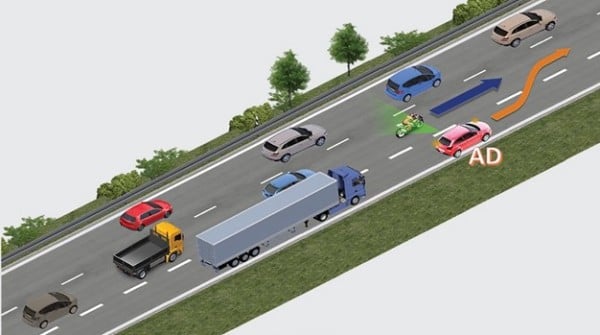
Automated systems in cars that handle lane changes but do not detect motorcyclists can result in serious road accidents. Image source: C2C-CC toolkit
